Advantages of XENON Pulsed Lamps as an alternative UV source for Surface Sterilization
By Dr. Stephen R. Wilk, Optical Engineer, XENON Corporation, Wilmington MA
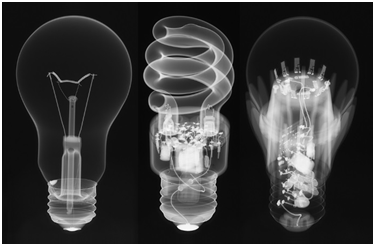
x-ray images of alternative ways to produce light
copyright Herminso Villarraga-Gómez, Nikon Metrology
With the recent trend away from the use of mercury lamps for disinfection, many companies are turning to Excimer Lamps (ELs) and Ultraviolet Light Emitting Diodes (UV LEDs) as readily available and viable alternatives. But most are overlooking more competitive options.
UV LED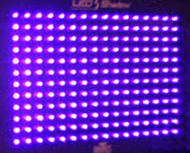
UV LEDs have the advantage of being relatively inexpensive, low-voltage, and compact sources that can put out a narrow wavelength band of light. They require no special handling and are mechanically robust. The LEDs require no “startup time”, but fire as soon as voltage is applied. Their lifetimes are well in excess of 20,000 hours, but not as long as those of more conventional LEDs, which are typically in excess of 100,000 hours. UV LEDs are also significantly more expensive than conventional LEDs (between several dollars and several hundred dollars, depending upon wavelengths, size, and supplier). Required voltages are also generally significantly higher for UV LEDs than for longer wavelength units. In addition, the efficiency, however, measured, is lower for UV LEDs than for other types of LEDs. Nevertheless, pricing, voltages, and efficiencies are still in the range that makes these units economically effective alternatives. The biggest drawback is the output power, which for deep ultraviolet LEDs currently goes up to the tens of milliwatts into the small footprint of an LED. By comparison, low-pressure cylindrical mercury lamps put out about 250 mW per cm of lamp length at 254 nm in all directions.
Excimer Lamps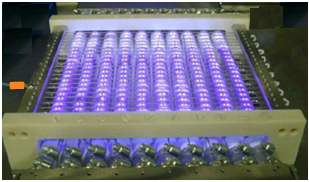
Excimer lamps are larger and require higher voltages, typically in the kilovolt range. Startup time is minimal (typically about a millisecond) and the output is into a relatively narrow waveband (typically tens of nm wide). Lifetimes are in excess of 5000 hours and outputs are tens of milliwatts/cm2, but radiated over a much larger area than with UV LEDs. Possibly the biggest drawback of excimer lamps is that, although there is a large range of possible emission wavelengths, only a few of these are at present commercially manufactured, and none of the available models has a good overlap with the DNA absorption band at 260 nm.
Pulsed Lamps
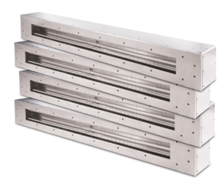
Image courtesy of and copyright XENON Corporation
Pulsed lamps can provide two significant advantages over either of these sources. The first advantage is far greater instantaneous light flux. This means that there is a very short duration yet very intense pulse of light, and that this produces greater lethality than if the same amount of light was released over a longer period of time. There is evidence that integrated irradiation is not subject to reciprocity; a given number of photons does not always kill the same number of micro-organisms. The rate at which the photons are delivered makes a difference1,2, and short pulses appear to be at an advantage. One possible explanation is that high fluences make it more likely that a given strand of DNA will suffer multiple points of damage before they can be repaired by the cell’s mechanisms, thus making it more likely that the organism will die. This places a premium on ultraviolet sources that deliver high-intensity flux.
The other advantage is that it is well-documented that although light coinciding with the DNA absorption peak at 260 nm ± about 20 nm, is essential for rapid and efficient sterilization (as was first uncovered brilliantly by H. S. Newcomber over a century ago,3,4,5) the sterilizing effect is enhanced by simultaneously irradiating the surface with light at longer wavelengths as well. Exactly which wavelengths and in which proportion is not clear, nor is precisely how this works. It has been argued that some photochemical, photophysical, or photothermal effect is responsible. A. Wekhof6,7 has argued that a range of wavelengths can be absorbed by the cell, causing a rapid and large rise in temperature that ruptures the organism. Other studies8,9,10 have argued that light at 405 nm directly breaks down cell walls. Still, others have suggested that the longer wavelength light hinders cellular repair mechanisms.11,12 Whatever the reason, it is evidently desirable to employ not only light near 260 nm but at one or more longer wavelengths, as well, in order to achieve the maximum lethality to microorganisms. UV LEDs and Excimer lamps only produce light near one wavelength, but broadband wavelength output is typical of xenon pulsed lamps, and the actual spectrum produced can be tailored by changing the gas mix, the applied voltage and current, altering the tube design, or by the use of filters.
For these reasons XENON pulsed lamps can provide better sterilization not only of bacterial, but also of viral and fungal contaminants.
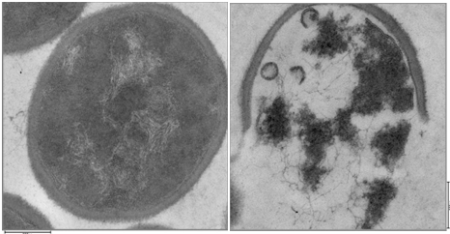
Illustrating lethal effect of XENON pulsed lamp light on a cell. Left – Before exposure; Right – after exposure, showing broken cell wall
Source: Krishnamurthy et al. Penn State University

37 responses to “Advantages of XENON Pulsed Lamps as an alternative UV source for Surface Sterilization”
louis vuitton tivoli pm
Generally speaking, it takes 6 weeks to color, nourish and polish the leather surface for a precious leather bag, and then the bag can be made. Cheap authentic Original Women louis Vuitton Sale|Authentic Women louis Vuitton Sale|Cheap Louis Vuitton Han…
… [Trackback]
[…] There you will find 90728 more Infos: ask-bioexpert.com/blog-post/advantages-of-xenon-pulsed-lamps-as-an-alternative-uv-source-for-surface-sterilization/ […]
… [Trackback]
[…] Read More on on that Topic: ask-bioexpert.com/blog-post/advantages-of-xenon-pulsed-lamps-as-an-alternative-uv-source-for-surface-sterilization/ […]
… [Trackback]
[…] Find More here to that Topic: ask-bioexpert.com/blog-post/advantages-of-xenon-pulsed-lamps-as-an-alternative-uv-source-for-surface-sterilization/ […]
… [Trackback]
[…] Info to that Topic: ask-bioexpert.com/blog-post/advantages-of-xenon-pulsed-lamps-as-an-alternative-uv-source-for-surface-sterilization/ […]
… [Trackback]
[…] Read More on that Topic: ask-bioexpert.com/blog-post/advantages-of-xenon-pulsed-lamps-as-an-alternative-uv-source-for-surface-sterilization/ […]
… [Trackback]
[…] There you will find 82939 more Info to that Topic: ask-bioexpert.com/blog-post/advantages-of-xenon-pulsed-lamps-as-an-alternative-uv-source-for-surface-sterilization/ […]
… [Trackback]
[…] Read More here on that Topic: ask-bioexpert.com/blog-post/advantages-of-xenon-pulsed-lamps-as-an-alternative-uv-source-for-surface-sterilization/ […]
… [Trackback]
[…] Read More Info here to that Topic: ask-bioexpert.com/blog-post/advantages-of-xenon-pulsed-lamps-as-an-alternative-uv-source-for-surface-sterilization/ […]
… [Trackback]
[…] Find More to that Topic: ask-bioexpert.com/blog-post/advantages-of-xenon-pulsed-lamps-as-an-alternative-uv-source-for-surface-sterilization/ […]
… [Trackback]
[…] Read More Information here to that Topic: ask-bioexpert.com/blog-post/advantages-of-xenon-pulsed-lamps-as-an-alternative-uv-source-for-surface-sterilization/ […]
… [Trackback]
[…] Find More Information here to that Topic: ask-bioexpert.com/blog-post/advantages-of-xenon-pulsed-lamps-as-an-alternative-uv-source-for-surface-sterilization/ […]
… [Trackback]
[…] Read More Info here on that Topic: ask-bioexpert.com/blog-post/advantages-of-xenon-pulsed-lamps-as-an-alternative-uv-source-for-surface-sterilization/ […]
… [Trackback]
[…] Find More to that Topic: ask-bioexpert.com/blog-post/advantages-of-xenon-pulsed-lamps-as-an-alternative-uv-source-for-surface-sterilization/ […]
… [Trackback]
[…] There you can find 91342 more Info on that Topic: ask-bioexpert.com/blog-post/advantages-of-xenon-pulsed-lamps-as-an-alternative-uv-source-for-surface-sterilization/ […]
… [Trackback]
[…] Read More to that Topic: ask-bioexpert.com/blog-post/advantages-of-xenon-pulsed-lamps-as-an-alternative-uv-source-for-surface-sterilization/ […]
… [Trackback]
[…] There you will find 24948 additional Info on that Topic: ask-bioexpert.com/blog-post/advantages-of-xenon-pulsed-lamps-as-an-alternative-uv-source-for-surface-sterilization/ […]
… [Trackback]
[…] Find More to that Topic: ask-bioexpert.com/blog-post/advantages-of-xenon-pulsed-lamps-as-an-alternative-uv-source-for-surface-sterilization/ […]
… [Trackback]
[…] Find More to that Topic: ask-bioexpert.com/blog-post/advantages-of-xenon-pulsed-lamps-as-an-alternative-uv-source-for-surface-sterilization/ […]
… [Trackback]
[…] Read More here on that Topic: ask-bioexpert.com/blog-post/advantages-of-xenon-pulsed-lamps-as-an-alternative-uv-source-for-surface-sterilization/ […]
… [Trackback]
[…] Information to that Topic: ask-bioexpert.com/blog-post/advantages-of-xenon-pulsed-lamps-as-an-alternative-uv-source-for-surface-sterilization/ […]
… [Trackback]
[…] Here you can find 17526 additional Info on that Topic: ask-bioexpert.com/blog-post/advantages-of-xenon-pulsed-lamps-as-an-alternative-uv-source-for-surface-sterilization/ […]
… [Trackback]
[…] Info on that Topic: ask-bioexpert.com/blog-post/advantages-of-xenon-pulsed-lamps-as-an-alternative-uv-source-for-surface-sterilization/ […]
… [Trackback]
[…] Information on that Topic: ask-bioexpert.com/blog-post/advantages-of-xenon-pulsed-lamps-as-an-alternative-uv-source-for-surface-sterilization/ […]
… [Trackback]
[…] Information to that Topic: ask-bioexpert.com/blog-post/advantages-of-xenon-pulsed-lamps-as-an-alternative-uv-source-for-surface-sterilization/ […]
… [Trackback]
[…] Find More to that Topic: ask-bioexpert.com/blog-post/advantages-of-xenon-pulsed-lamps-as-an-alternative-uv-source-for-surface-sterilization/ […]
… [Trackback]
[…] Read More to that Topic: ask-bioexpert.com/blog-post/advantages-of-xenon-pulsed-lamps-as-an-alternative-uv-source-for-surface-sterilization/ […]
… [Trackback]
[…] Read More Info here on that Topic: ask-bioexpert.com/blog-post/advantages-of-xenon-pulsed-lamps-as-an-alternative-uv-source-for-surface-sterilization/ […]
… [Trackback]
[…] Read More Info here on that Topic: ask-bioexpert.com/blog-post/advantages-of-xenon-pulsed-lamps-as-an-alternative-uv-source-for-surface-sterilization/ […]
… [Trackback]
[…] Here you can find 26256 additional Info on that Topic: ask-bioexpert.com/blog-post/advantages-of-xenon-pulsed-lamps-as-an-alternative-uv-source-for-surface-sterilization/ […]
… [Trackback]
[…] Find More Info here on that Topic: ask-bioexpert.com/blog-post/advantages-of-xenon-pulsed-lamps-as-an-alternative-uv-source-for-surface-sterilization/ […]
… [Trackback]
[…] There you can find 72933 additional Information on that Topic: ask-bioexpert.com/blog-post/advantages-of-xenon-pulsed-lamps-as-an-alternative-uv-source-for-surface-sterilization/ […]
… [Trackback]
[…] Here you can find 62107 more Info on that Topic: ask-bioexpert.com/blog-post/advantages-of-xenon-pulsed-lamps-as-an-alternative-uv-source-for-surface-sterilization/ […]
… [Trackback]
[…] There you will find 42289 more Info to that Topic: ask-bioexpert.com/blog-post/advantages-of-xenon-pulsed-lamps-as-an-alternative-uv-source-for-surface-sterilization/ […]
… [Trackback]
[…] Read More Information here on that Topic: ask-bioexpert.com/blog-post/advantages-of-xenon-pulsed-lamps-as-an-alternative-uv-source-for-surface-sterilization/ […]
… [Trackback]
[…] Read More Info here to that Topic: ask-bioexpert.com/blog-post/advantages-of-xenon-pulsed-lamps-as-an-alternative-uv-source-for-surface-sterilization/ […]
… [Trackback]
[…] Read More on that Topic: ask-bioexpert.com/blog-post/advantages-of-xenon-pulsed-lamps-as-an-alternative-uv-source-for-surface-sterilization/ […]